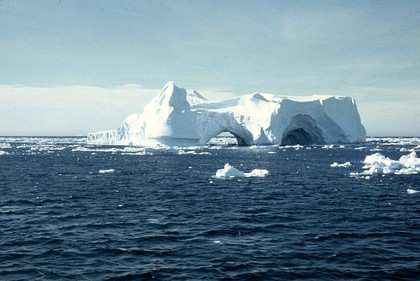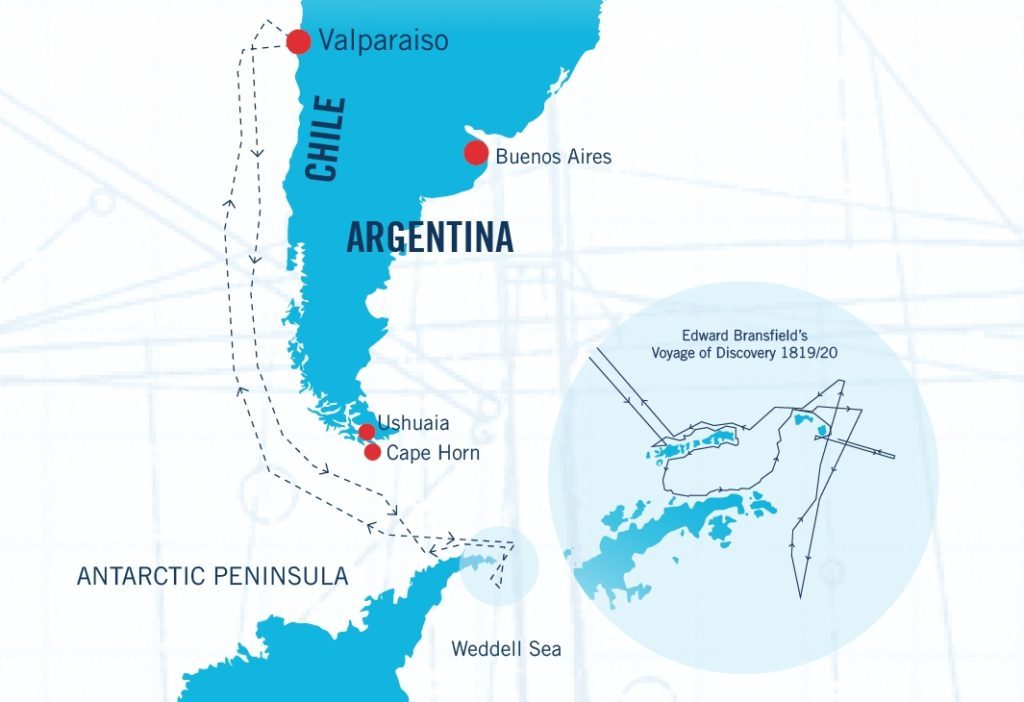
The first sighting of Antarctica.
I have taken much of the following information from the excellent site http://rememberingedwardbransfield.ie/ and I encourage you to take a look.
The journey
Edward Bransfield was given command of a ship, the ‘Williams’, a small two-masted brig of just 216 tons, to locate and map any new territories to the south and to take possession for King George IV. He was also ordered to observe any wildlife and inhabitants and collect specimens of rock and wildlife they encountered. Bransfield was also ordered to “conceal every discovery that you have made during your voyage” and to keep a “secret journal” to hand over on his return.
The ‘Williams’ was provisioned for a year and Bransfield set sail on 19th December 1819 from Valparaiso, Chile. The 3218 Kilometre (2,000 mile) journey from Valparaiso to the South Shetlands was fraught with danger for the small vessel, which had not been strengthened against the ice, and had sailed without a support ship, in notoriously turbulent seas where cross currents and high winds are a constant threat.
It took nine days to travel the first 10 km (6 miles) alone because of the poor conditions and banks of swirling fog closed in as ‘Williams’ entered the fearsome waters of the Drake Passage.
The first sight of land was made on 16th January 1820 as Bransfield ran along the South Shetland Islands seen by Smith a few months before. A small party went ashore on King George Island to formally claim the territory for Britain and Bransfield then turned south into the unknown seas.
This deep stretch of water, which is about 96 km (60 miles) wide and 321 km (200 miles) long, is today known as the Bransfield Strait and separates the South Shetlands from the Antarctic Peninsula.

On Sunday, 30th January 1820, one of Bransfield’s junior officers, Midshipman C.W. Poynter, who kept a personal log of the journey, reported;
The first sighting
‘At 3 our notice was attracted by three very large Iceberges and 20 minutes after we were unexpectedly astonished by the discovery of land……shortly after, as the haze cleared, Williams was “half encompassed by islands” and encountered a series of “immense mountains, rude crags and barren ridges covered with snow…We can positively assert that we saw land in 64° S still trending to the Eastward…Our theme of conversation was the idea of having by the direction of land took found what might possibly lead to the discovering of the long contested existence of a Southern Continent’
Bransfield had discovered a rocky chunk of the north-western shore of the Antarctic Peninsula which was named Trinity Land. A small nearby island was called Tower Island and in the distance the party could clearly make out an imposing snow-capped mountain. That 762 m(2,500 ft) peak is today named Mount Bransfield.

The ‘Williams’ was rocked by gales and very rough seas over the following weeks as Bransfield and his crew endeavoured to extend their new discoveries. Occasionally, the ship broke into the Weddell Sea or ran along the eastern coast of the Peninsula and on 23th February 1820 the ‘Williams’ reached 64° 56’ S. At one point, ‘Williams’ steered close to Elephant Island where, a century later, Shackleton’s men would be marooned after the sinking of his ship, Endurance.
Bransfield turned north, (his decision partly made because some of his crew were dressed for Valparaiso weather and not the Antarctic weather for the whole trip!), and re-entered Valparaiso on 14th April 1820 at the end of an epic and hugely challenging voyage. Not a single man was lost.
The controversy
A 1982 study ‘Antarctica Observed’ concluded that the Russian, Von Bellinghausen, was the first to sight Antarctica.
However, Bellinghausen saw and reported: “ice mountains” and “continuous ice” giving the impression that he had sighted the continent but the ‘Belfast Newsletter’ of October 20, 1821, reported Bellingshausen as saying: “…there is no southern continent or should there be one, it must be inaccessible from being covered with perpetual snows, ice, etc.”
In the 1990’s a journal was discovered in a library archive in New Zealand. It was the journal of Bransfield’s midshipman C.W.Poynter and sheds new light on Bransfield’s discovery. You can read excerpts from it below and Rip Bulkeley’s award winning book of 2014 on the Bellingshausen expedition (Bellingshausen and the Russian Antarctic Expedition, 1819-21) makes the most comprehensive study of the Bellingshausen evidence and comes down clearly on the side of Bransfield.
Bransfield’s legacy
Later explorers travelled in the footsteps of Bransfield. Mount Bransfield was named by renowned French explorer Dumont D’urville during his 1838-40 expedition and had Bransfield’s route on his own charts. He said in his log book ‘This is why I named this mountain Bransfield, more to honour the memory of the only seaman who has been in these seas for science’.
James Weddell who named the Bransfield Strait after him said ‘Mr. Edward Bransfield acted with great boldness in obtaining a knowledge of this land; but circumstances did not admit his extending or pursuing his observations, so to give a particular account of it’.
Bransfield left the navy in the 1820s and returned to the sea as a merchant mariner, while Bellingshausen resumed his career in the Russian navy. Edward Bransfield died a forgotten man in Brighton on October 31, 1852 at the age of 67. He outlived Bellingshausen, who died on January 25, 1852, by nine months.
They were both great men, both brave polar explorers, and they both advanced our knowledge of the world, but it looks like Edward Bransfield was the first to sight the Antarctic mainland.
Here is a great video about Bransfield and his life (21 minutes) that the ‘Remembering Edward Bransfield’ group put together:
